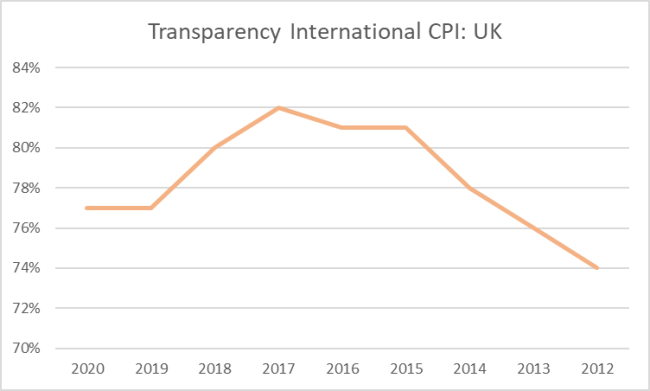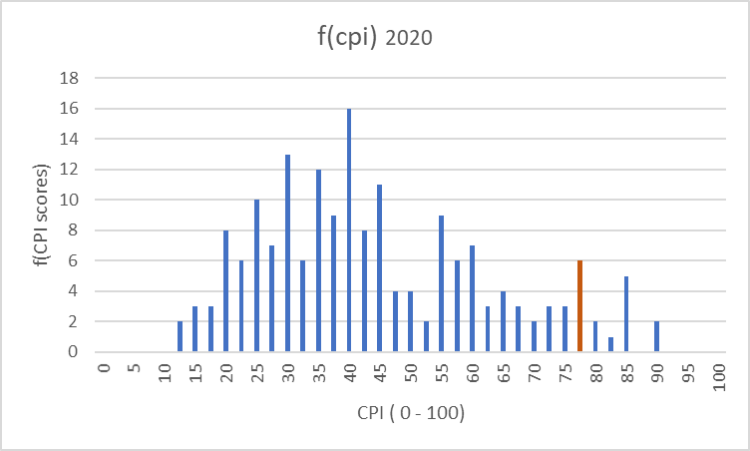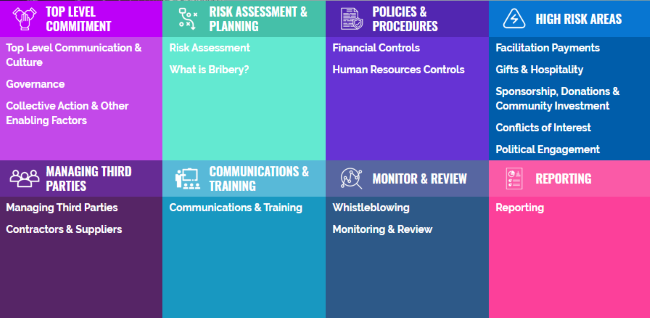Sadly I have been looking to see what’s being said about Corruption and Anti-Corruption. Here are my links and notes. I have some links on management strategy, and some specifically on action plans inc. current advice from the MoJ. Interestingly, to me, the action plans share many ideas from risk management practices and IT Security controls that I have been working with for many years. In Apr 2021, I added some links on Transparency International’s Corruptions Perception Index. …
Links, theory and the UK law
- Confronting corruption at Mckinsey, some examples, a taxonomy inc. employee fraud, and inoculating the organisation, sufficient and well trained staff, clear leadership and accept the full cost which will include lost business
- Anti-corruption in business, a 6 point plan with further reading from UN Global Compact; looks a bit six sigma perhaps the linked articles are better.
- Anti-corruption white paper published by Good Corporation and their white paper, Combating corruption: are businesses doing enough? This would seem to be a company that performs anti-corruption risk assessments and like Gartner reports on their customer portfolio. This has a 1st level control taxonomy. The control assessments are familiar to those who perform control assessments.
- From Transparency International, The Bribery Act: ADEQUATE PROCEDURES GUIDANCE, this page has a series of chcklists and tool kits and points at key Govt resources, some of which I repeat on this page. The quote below comes from this page. The also point at further resources which they host at https://www.antibriberyguidance.org
I summarise as follows,
The definition of an act of bribery is quite low, any act designed to obtain or having the effect of obtaining advantage through the ‘improper performance’ of another person.
From the MOJ Guidance document (see below),
‘Improper performance’ is … performance which amounts to a breach of an expectation that a person will act in good faith, impartially, or in accordance with a position of trust.
For the purposes of deciding whether a function or activity has been performed improperly the test of what is expected is a test of what a reasonable person in the UK would expect in relation to the performance of that function or activity.
TI also state on their page
The UK Bribery Act, which was passed in 2010, introduces an offence of corporate failure to prevent bribery. The defence for a company against this liability is to prove that it had adequate procedures in place to prevent bribery. This Guidance from Transparency International UK (TI-UK) is designed to assist companies to comply with the Bribery Act by providing clear, practical advice on good practice anti-bribery systems that in TI-UK’s opinion constitute ‘adequate procedures’ for compliance with the Bribery Act.
And so advice on compliance, including that from the UK Govt.,
- https://www.sfo.gov.uk/publications/guidance-policy-and-protocols/bribery-act-guidance/
- http://www.justice.gov.uk/downloads/legislation/bribery-act-2010-guidance.pdf
A ‘relevant commercial organisation’ is defined at section 7(5) as a body or partnership incorporated or formed in the UK irrespective of where it carries on a business, or an incorporated body or partnership which carries on a business or part of a business in the UK irrespective of the place of incorporation or formation.
So it looks like unincorporated associations are exempt.
The MOJ Guidance has six principles, which I should summarise here,
- Proportionate procedures: A commercial organisation’s procedures to prevent bribery by persons associated with it are proportionate to the bribery risks it faces and to the nature, scale and complexity of the commercial organisation’s activities. They are also clear, practical, accessible, effectively implemented and enforced.
- Top-level commitment: The top-level management of a commercial organisation (be it a board of directors, the owners or any other equivalent body or person) are committed to preventing bribery by persons associated with it. They foster a culture within the organisation in which bribery is never acceptable.
- Risk Assessment: The commercial organisation assesses the nature and extent of its exposure to potential external and internal risks of bribery on its behalf by persons associated with it. The assessment is periodic, informed and documented.
- Due diligence: The commercial organisation applies due diligence procedures, taking a proportionate and risk based approach, in respect of persons who perform or will perform services for or on behalf of the organisation, in order to mitigate identified bribery risks.
- Communication (including training): The commercial organisation seeks to ensure that its bribery prevention policies and procedures are embedded and understood throughout the organisation through internal and external communication, including training, that is proportionate to the risks it faces.
- Monitoring and review: The commercial organisation monitors and reviews procedures designed to prevent bribery by persons associated with it and makes improvements where necessary.
I also found,
- this article, on What are Controls? At Pearson IT Certification, quoting “Information Security: Principles and Practices, 2nd Edition“, they say, “The Three Types of Security Controls Are Preventative, Detective, and Responsive/Corrective.. Controls (such as documented processes) and countermeasures (such as firewalls) must be implemented as one or more of these previous types, or the controls are not there for the purposes of security”.
- A primer on modern corruption., from Global Risk Insights. I took the featured picture from here.
- and a blog article I wrote on the Spanish anti-corruption laws, International pursuit of corruption/. Can’t remember why now. 🤔
- And this, https://complianceconcourse.willkie.com/resources/anti-bribery-and-corruption-uk-statute-of-limitations, the Bribery Act has no statute of limitations but is not retrospective, any acts need to have been committed before 1 July 2011.
Transparency International and their CPI
The events of the last 11 months in the UK with respect to Govt procurement in response to the pandemic in the UK and the EU leads me back to TI.
- CPI 2020: Trouble in the top 25 countries, a categorisation of the top 25 countries, as in clean, the UK is now 14th with a score of 77. They analyse the problems in the top 25 in this article. as unaccountable financial services, poor money laundering controls, influence peddling, international commercial bribery and inadequate transparency in govt. responses to coronavirus.
- The CPI home page, the CPI, includes methodology descriptions, this needs to be read and understood.
- The CPI UK Page … standing still in rank, improving in score, (how did that happen?)
- Western Europe and EU: stagnating anti-corruption efforts and weakening democratic institutions, dated Jan 2019, i.e. 2018 before the UK’s 2019 election and before the pandemic.
- CPI 2021 – As anti-corruption efforts stagnate worldwide, human rights and democracy are also under assault. Also “Trouble at the Top“, and the TI UK’s call for the Ministerial code to become law.
What they say about the UK,
As the rotating president of the G7, the British Government has the chance to show leadership this year, encouraging major western economies to tackle these flows of dirty money and demonstrate whether integrity is to be one of their shared values.
The UK scores for the last eight years.

and the frequency distribution for 2020, the group with UK is the orange bar.

There maybe more behind a paywall on the UK. I am concerned, given the furore about the extraction of public money by Tory donors and the private attempts to stop it that the UK has not sunk lower, not to mention the Arcuri affair.

Today I added the links on the Corruption Perceptions Index, I need to look at the methodology and see if I can get what they say about the UK but is there a problem here?
Now we have the 2022 CPI, I have added some comments in the CPI section of the page.